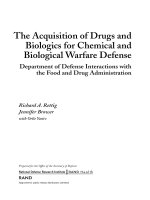drug reactions
Bạn đang xem bản rút gọn của tài liệu. Xem và tải ngay bản đầy đủ của tài liệu tại đây (22.56 KB, 1 trang )
In order for a chemical to be considered a drug it must have the
capacity to affect how the body works to be biologically active. No
substance that has the power to do this is completely safe, and drugs are
approved only after they demonstrate that they are relatively safe when
used as directed, and when the benefits outweigh their risks. Thus, some
very dangerous drugs are approved because they are necessary to treat
serious illness. Digitalis, which causes the heart muscle to contract, is a
dangerous drug, but doctors are permitted to use it because it is vital for
treating patients whose heart muscle is weak. A drug as potent as
digitalis would not be approved to treat such minor ailments as temporary
fatigue because the risks outweigh the benefits. Many persons suffer ill
effects from drugs even though they take the drug exactly as directed by
the doctor or the label. The human population, unlike a colony of ants or
bees, contains a great variety of genetic variation. Drugs are tested on at
most a few thousand people. When that same drug is taken by millions,
some people may not respond in a predictable way to the drug. A person
who has a so-called idiosyncratic response to a particular sedative, for
example, may become excited rather than relaxed. Others may be
hypersensitive, or extremely sensitive, to certain drugs, suffering
reactions that resemble allergies. A patient may also acquire a tolerance
for a certain drug. This means that ever-larger doses are necessary to
produce the desired therapeutic effect. Tolerance may lead to
habituation, in which the person becomes so dependent upon the drug
that he or she becomes addicted to it. Addiction causes severe
psychological and physical disturbances when the drug is taken away.
Morphine, cocaine, and Benzedrine are common habit-forming drugs.
Finally, drugs often have unwanted side effects. These usually cause only
minor discomfort such as a skin rash, headache, or drowsiness. Certain
drugs, however, can produce serious, even life-threatening adverse
reactions. For example, the drug Thalidomide was once called one of the
safest sedatives ever developed, but thousands of women in the United
Kingdom who took it during pregnancy gave birth to seriously deformed
babies. Other adverse reactions stem from mixing drugs. Thus, taking
aspirin, which has blood-thinning qualities, for a headache can be very
harmful if one is also taking other blood-thinning drugs such as heparin or
dicumarol.









